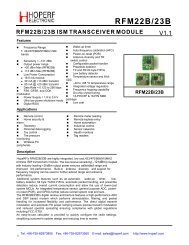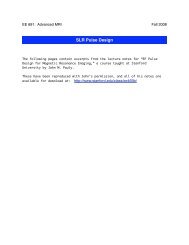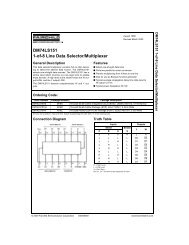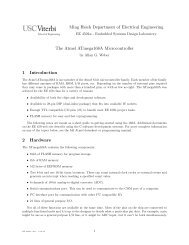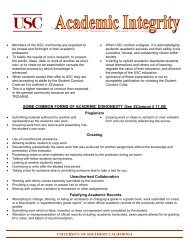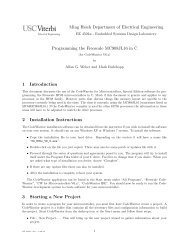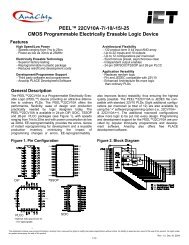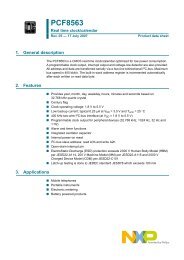EE 591 K. Nayak MR Imaging and Reconstruction Homework #4 ...
EE 591 K. Nayak MR Imaging and Reconstruction Homework #4 ...
EE 591 K. Nayak MR Imaging and Reconstruction Homework #4 ...
You also want an ePaper? Increase the reach of your titles
YUMPU automatically turns print PDFs into web optimized ePapers that Google loves.
...<br />
> M = xrot(gamma*B1*dt) *M; % excitation_x: rotation about the x axis<br />
> M = zrot(2*pi*df*dt) *M; % precession due to off-resonance (df)<br />
> M = zrot(gamma*(Gx*x+Gy*y+Gz*z)*dt) *M;<br />
% precession due to Gradients<br />
> M = A*M+b*Mo; % relaxation<br />
In this problem, you will be simulating excitation pulses, off-resonance, <strong>and</strong> gradients.<br />
Relaxation is ignored.<br />
Browse the provided simpulse.m file <strong>and</strong> verify that it simulates the rotations experienced<br />
by a spin at position z due to a given b1 (RF pulse in Gauss), gz (Z gradient<br />
in Gauss/cm), <strong>and</strong> df (off-resonant frequency in Hz).<br />
For the following two parts assume that magnetization begins at equilibrium, that<br />
Mo = 1, <strong>and</strong> ignore relaxation. The waveforms you will load have a sampling rate of<br />
4µs. And gamma is 26752 rad/s/G.<br />
(a) Load the slice selective RF pulse sliceselect.mat which contains an RF pulse<br />
<strong>and</strong> associated Z-gradient. Simulate the excitation profile for spins with zpositions<br />
from -1 cm to 1 cm in 0.2 mm (or smaller) increments. Plot Mx,<br />
My, <strong>and</strong> Mz as a function of z position.<br />
Repeat the simulation assuming off-resonance with ∆f = -440 Hz (fat). What<br />
happens to the slice profile? What are the implications if we use this excitation<br />
pulse to image a slice in the body that contains both water <strong>and</strong> fat?<br />
(b) Load the spectral-spatial RF pulse specspat.mat which also contains an RF<br />
pulse <strong>and</strong> associated Z-gradient. This is an interesting pulse design that excites<br />
a limited range of frequencies.<br />
Plot Mx, My, <strong>and</strong> Mz as a function of z position (for ∆f = 0).<br />
Plot Mz, My, <strong>and</strong> Mz as a function of off-resonance (for z = 0). Let ∆f range<br />
from -1 kHz to 1 kHz in 25 Hz increments.<br />
OPTIONAL PART (if time permits): Make an image of the resulting transverse<br />
magnetization (|Mr| = |Mx + iMy|), for locations ranging from z = -1 cm to<br />
1 cm, <strong>and</strong> ∆f ranging from -1 kHz to 1 kHz in 25 Hz increments.<br />
(c) Modify simpulse.m to incorporate relaxation. Assume T1 = 100 ms. Consider<br />
the slice selective pulse in part (a) <strong>and</strong> determine how small T2 needs to be<br />
before it noticeably affects the excitation profile.<br />
Explain the slice profile changes that you notice.<br />
4



